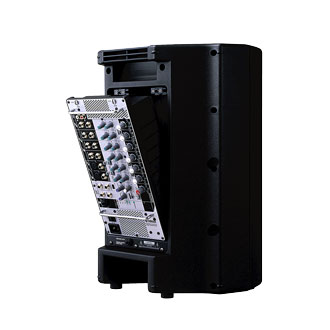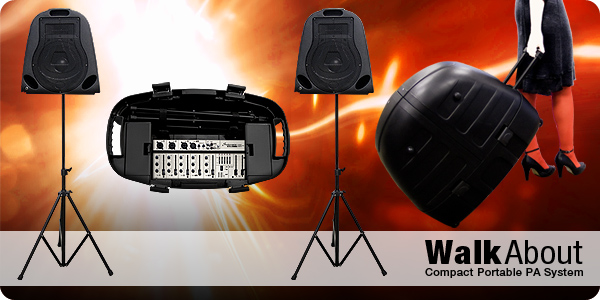If you are new to P.A. equipment, here's a terminology list and a basic indication
of how to connect the necessary equipment : -
Basic Terminology
Amplifier - The part of the system that amplifies the sound. May be purchased independently (with a separate mixer) or can be purchased as an integrated unit (a powered mixer).
Channels - 'Input' channels usually relate to those items coming into the amplifier/mixer (microphones,
or other equipment which needs to be amplified or mixed). 'Output' channels
usually relate to those items leaving the amplifier/mixer (speakers/monitors
etc.)
Delay - An electronic
circuit or effects unit - purpose being to delay the audio signal for a specific
period of time.
Equaliser - Equipment
used to alter specific frequencies of the sound, thus having a precise overall
effect on the sound heard from the speakers. This equipment is commonly integrated
into an amplifier or mixer, and is now seldom used as a stand-alone unit.
Fader - Another
name for an audio level control. Usually refers to a straight-line slider rather
than a rotary control.
Jack - Commonly used term
to refer to an 'input/output' socket.
Level - Another
word for signal voltage, (volume, strength or power.)
Line-In (Input/Return) - This
is where a signal enters the amplifier/mixer.
Line-Out (Output/Send) - This
is where a signal leaves the amplifier/mixer.
Master Volume - Microphone
volumes and backing track levels can be controlled independently via the input
channels, however the master volume is used to increase or decrease the sound
of the overall performance (microphone and instruments simultaneously.)
Mixer : This is the piece of equipment which enables you to control various settings such as the volume of individual microphones/instruments, pan, bass, midrange and treble. There may also be onboard effects such as reverb, chorus, delay, echo etc. Many mixers are referred to as having 6, 8, 12, channels etc. This relates to the number of different microphones or instruments that can be connected to the mixer. E.g. three connected microphones would use 3 channels (or lines) of the available 8 on an eight channel mixer. A powered mixer is an integrated unit that can combine amplifier, equaliser, mixing deck and effects.
Monitors - Additional speakers,
commonly placed in front of the vocalist/instrumentalist, enabling them to clearly
hear their own sound/performance.
Pan - This refers to controls
on the mixer used to adjust the amount of volume sent between left and right
speakers. Although very useful when sound from a left or right speaker may be
hindered or obtrusive, many people usually leave the panning knobs central.
Phantom Power - A system
providing power for condenser microphones from the mixer. Most quality microphones
are designed to use +48 VDC phantom power.
Return - A mixer
line input dedicated to the task of returning sound from effects devices such
as reverb units, echo units etc.
Phono Plug/Jack - Commonly
found on consumer audio equipment. One of the most inexpensive connection types
- use alternatives if available on your equipment.
XLR Connector - Three-pin connector used in audio for transmitting a balanced signal (microphones etc.) - also referred to as a Cannon connector.
Basic P.A. setup
An easy way to remember the signal
direction (whether to plug your equipment into inputs or outputs), is to remember
that anything traveling from the direction of your microphone into the
mixer should generally be plugged into the inputs of the mixer, whilst
anything traveling out from the mixer (to the speakers/monitors etc.),
should generally be plugged into the output. Always remember the amplifier/mixer
as the central piece of equipment, and you shouldn't go far wrong.
1. Firstly, make sure all plugs
are removed from sockets and power is off.
2. Plug the end of the microphone cord into the input socket
of the mixer (input line 1 of the mixer could be used). There may be two
alternative input jacks - a standard jack plug or XLR connection. Many corded
microphones have the XLR type connection, however either of these connections
will suffice for a basic setup.
3. Plug one end of the speaker cable into the output socket
of the mixer/amplifier. The speaker outputs are frequently found at the
back of a mixer.
4. Plug the other end of the speaker cable into the input socket
on the rear of the speaker.
5. Repeat steps 3 and 4 with the speaker cable for the additional speaker.
6. Plug the amplifier/mixer into the mains.
7. Switch on.
There
we have it! Your first P.A. setup.
P.A.
setup including monitors
Monitors,
although not suitable for every environment, should become an essential part
of every professional musician's equipment. The reason for this is that on many
occasions a vocalist or instrumentalist will be stood slightly behind the speakers.
This makes it almost impossible to hear the clarity and sound that the audience
is hearing. The performer does not necessarily want to hear the sound as loud
as the audience, however the monitor relays an isolated sound to the performer,
so he/her can easily distinguish the clarity, without too many distractions.
For this reason, monitors face towards the stage and are are usually angled
from the floor directly toward the performer.
The setup should follow the same as above,
however if your mixer/amplifier has a monitor out socket, this can be used with
a separate amplifier to allow independent controlling of volume levels to the
monitors (N.B. you would want to hear sound from the monitors at a lower level
than that of the main speakers). Many monitors have their own volume controls
for this purpose. Powered monitors (monitors which have their own built-in amplifier),
are available which avoid the need of a separate amplifier.






